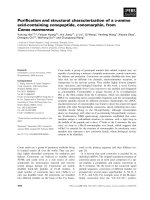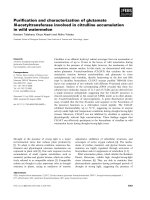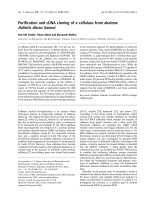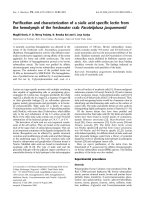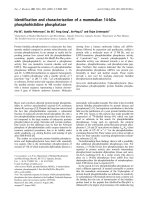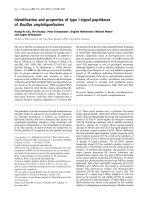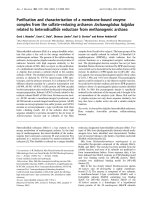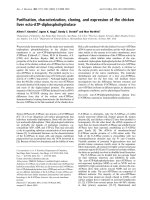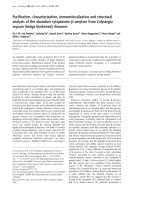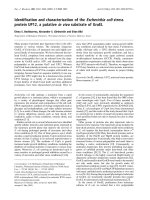Báo cáo Y học: Purification and properties of the extracellular lipase, LipA, of Acinetobacter sp. RAG-1 docx
Bạn đang xem bản rút gọn của tài liệu. Xem và tải ngay bản đầy đủ của tài liệu tại đây (273.57 KB, 9 trang )
Purification and properties of the extracellular lipase, LipA,
of
Acinetobacter
sp. RAG-1
Erick A. Snellman
1,2
, Elise R. Sullivan
1,3
and Rita R. Colwell
1,4
1
Center of Marine Biotechnology, University of Maryland Biotechnology Institute, MD, USA;
2
HQ USAFA/DFB, USAF Academy,
CO, USA;
3
Department of Microbiology, University of New Hampshire, USA;
4
Department of Cell and Molecular Biology,
University of Maryland, USA
An extracellular lipase, LipA, extracted from Acinetobacter
sp. RAG-1 grown on hexadecane was purified and proper-
ties of the enzyme investigated. The enzyme is released into
the growth medium during the transition to stationary
phase. The lipase was harvested from cells grown to sta-
tionary phase, and purified with 22% yield and > 10-fold
purification. The protein demonstrates little affinity for
anion exchange resins, with contaminating proteins removed
by passing crude supernatants over a Mono Q column. The
lipase was bound to a butyl Sepharose column and eluted in
a Triton X-100 gradient. The molecular mass (33 kDa) was
determined employing SDS/PAGE. LipA was found to be
stable at pH 5.8–9.0, with optimal activity at 9.0. The lipase
remained active at temperatures up to 70 °C, with maximal
activity observed at 55 °C. LipA is active against a wide
range of fatty acid esters of p-nitrophenyl, but preferentially
attacks medium length acyl chains (C
6
,C
8
). The enzyme
demonstrates hydrolytic activity in emulsions of both
medium and long chain triglycerides, as demonstrated by
zymogram analysis. RAG-1 lipase is stabilized by Ca
2+
,
with no loss in activity observed in preparations containing
the cation, compared to a 70% loss over 30 h without Ca
2+
.
The lipase is strongly inhibited by EDTA, Hg
2+
,andCu
2+
,
but shows no loss in activity after incubation with other
metals or inhibitors examined in this study. The protein
retains more than 75% of its initial activity after exposure to
organic solvents, but is rapidly deactivated by pyridine.
RAG-1 lipase offers potential for use as a biocatalyst.
Keywords: lipase; LipA; Acinetobacter sp.RAG-1;protein
purification; zymogram.
Lipases are glycerol ester hydrolases (EC 3.1.1.3) that
catalyze the hydrolysis of triacylglycerols to free fatty acids
and glycerol. They resemble esterases in catalytic activity,
but differ in that their substrates are water-insoluble fats
containing medium to long fatty acyl chains [1]. Lipases are
further distinguished from esterases in that they are
activated at the substrate–water interface [2]. Interest in
lipases has increased recently due to their recognition as
important virulence factors [3] and their biotechnological
potential. Lipases have proven to be versatile enzymes in
nonaqueous solvent systems in which they catalyze the
synthesis of a variety of acylglycerols and specialized esters
via transesterification. Lipases demonstrating high activity
under alkaline conditions are used as additives in detergents,
one of the largest industrial uses of these enzymes [4].
Lipase-catalyzed synthesis of structured triacylglycerols
comprised of both long and medium chain fatty acids has
been investigated as a means of providing single substitutes
for mixed acylglycerides in dietary applications [5]. In both
hydrolysis and synthesis reactions, lipases demonstrate
stereo- and regio-selectivity, making them good candidates
for production of optically active compounds used in the
pharmaceutical and agricultural industries.
Previously, we reported on the cloning and sequence of an
extracellular lipase (LipA) from Acinetobacter sp. RAG-1,
which contained several conserved regions common to
bacterial lipases [6]. This strain has also been characterized
with respect to its production of a powerful emulsifying
agent, termed emulsan [7,8]. Emulsan is a heteropolysaccha-
ride complex produced as a capsule in cells grown on
hydrocarbons and ethanol as sole carbon sources and is
released into the growth medium during transition to
stationary phase [8,11]. The bioemulsifier is composed of a
polysaccharide backbone with attached fatty acids and
noncovalently bound proteins [9,10]. Because LipA is also
produced during growth on hydrocarbons [6], despite the
fact that alkanes are not lipase substrates, we are currently
investigating the potential role of LipA in facilitating
emulsification by interaction with emulsan. To this end we
report here the purification and characterization of LipA and
discuss its potential as a biocatalyst in synthesis reactions and
in the context of related biotechnological applications.
MATERIALS AND METHODS
Media and culture conditions
Acinetobacter sp. RAG-1 (ATCC 31012) recovered from
frozen stock ()80 °C) was used to inoculate Spirit Blue agar
(Difco, Liverpool, Australia) cultures, which were incubated
Correspondence to R. R. Colwell, Center of Marine Biotechnology,
Suite 236, Columbus Center, 701 East Pratt Street,
Baltimore, Maryland, USA, 21202.
Fax: + 1 703 292 9232, Tel.: + 1 703 292 9232,
E-mail:
Abbreviations: LNPS, low nitrogen, phosphorous, sulfur; pNPP,
p-nitrophenyl palmitate; pNP, p-nitrophenol; HIC, hydrophobic
interaction chromatography.
(Received 5 April 2002, revised 23 July 2002,
accepted 6 September 2002)
Eur. J. Biochem. 269, 5771–5779 (2002) Ó FEBS 2002 doi:10.1046/j.1432-1033.2002.03235.x
overnight at 37 °C. Single colonies were selected for inocu-
lation of 100 mL low nitrogen, phosphorous, sulfur (LNPS)
medium consisting of (per litre): KH
2
PO
4
,3.3g;Na
2
HPO
4
,
2.2 g; Na
2
SO
4
,1.0g;NH
4
NO
3
,1.0g;NaCl,5.0g;MgSO
4
,
0.29 g; CaCl
2
,0.05g;FeSO
4
, 1 mg (pH 7.0). Hexadecane
(10 m
M
) was employed as carbon source. Inocula were
grown overnight at 30 °C, with shaking at 200 r.p.m. in a
rotary incubator/shaker (New Brunswick Scientific, Edison,
NJ). Aliquots from overnight cultures were transferred to
freshLNPSamendedwithhexadecaneandusedforgrowth
studies and lipase production. Cultures were grown (as
above) for 48 h prior to harvest. Extracellular lipase activity
in these cultures ranged from 0.2 to 0.35 units (U) mL
)1
.
Lipase assay
Lipase activity was measured by hydrolysis of p-nitrophenyl
palmitate (pNPP) in deoxycholate buffer, as described
elsewhere [6,12]. All assay reagents were purchased from
Sigma (St. Louis, MO). Samples (20 lL)500 lL) were
added to prewarmed (30 °C) phosphate buffer (50 m
M
,
pH 8) containing 0.2% (w/v) sodium deoxycholate and
0.1% (w/v) gum arabic, final volume 3.0 mL. The mixture
was incubated for 5 min at 30 °C. pNPP (0.30 m
M
final
concentration) was added and the mixture shaken, allowing
the reaction to proceed for 3 min. Lipase activity was
determined by the rate of p-nitrophenol production (pNP),
measured at 405 nm in a model DU640 spectrophotometer
(Beckman Coulter, Fullerton, CA). Lipolytic activity was
determined, using substrate free blanks as control. The
reaction rate was calculated from the slope of the absorb-
ance curve, using software installed by the manufacturer
(Beckman Coulter). The extinction coefficient under the
conditions described was 17454 LÆmolÆcm
)1
[6]. One unit of
enzyme activity is defined as the amount of enzyme forming
1 lmol of pNP min
)1
. Lipase specific activity was expressed
as unitsÆmg protein
)1
. When examining the effect of tem-
perature on activity, enzyme preparations were incubated at
different temperatures for 5 min and assayed at the
incubation temperature.
During growth studies, cell bound and cell free lipase
activities were determined as follows: cells were pelleted,
washed twice, and resuspended in sterile LNPS prior to
assay. Supernatants were filtered (0.2 lm Tuffryn mem-
brane, Gelman Laboratories, Ann Arbor, MI, USA) and
assayed separately.
Protein concentration
Protein was measured using the method of Bradford [13],
with BSA as standard. Detergent-compatible BCA protein
assay (Pierce, Rockford, Il) was used to determine protein
concentration in samples containing Triton X-100. Total
protein of cellular fractions was determined after cell
disruption by sonication (3 · 30 s) using a Branson model
450 sonicator fitted with a 1.0-mm microtip. Protein
concentration was routinely used as a measure of cell
growth in hydrophobic media [14,15].
Lipase purification
After incubation for 48 h in LNPS amended with 10 m
M
hexadecane, cells were removed by centrifugation (10 000 g)
at 4 °C and the supernatants pooled. To increase the yield of
lipase, 2 m
M
CaCl
2
and 2 m
M
MgCl
2
were added during
magnetic stirring and the crude supernatant centrifuged a
second time. To remove residual hexadecane, the combined
sample was allowed to stand for 30 min prior to passage
through a coarse glass fiber filter, after which the sample was
filtered (0.2 lm).
Supernatants were concentrated by ultrafiltration, using
an Amicon RA2000 filter unit fitted with an S1Y10 spiral
membrane (10 000 MW, 20 psi) and the sample volume
reduced approximately 10–15-fold to 200 mL. After con-
centration, a serine protease inhibitor, phenylmethanesulfo-
nyl fluoride, was added (0.2 m
M
) to reduce loss from
proteolytic activity. Concentrated supernatants were ultra-
centrifuged at 141 000 g (1 h) at 4 °C. Supernatants con-
taining lipase were divided into 35 mL aliquots and stored
at )80 °C prior to chromatography.
Preliminary experiments to investigate binding properties
of the lipase, using ion exchange resins, showed little (10%)
affinity for the matrices under the conditions employed.
However, other proteins were effectively bound, yielding
significant purification. Therefore, anion exchange was
employed as a preliminary step to hydrophobic interaction
chromatography (HIC). Samples were dialyzed overnight
against 20 m
M
Tris/HCl buffer (pH 8.0), followed by
passage through an Econo-Pac Mono Q cartridge (5 mL)
(Bio-Rad, Hercules, CA) at approximately 1 mL min
)1
,
prior to loading on the hydrophobic matrix.
HIC methods were employed as described elsewhere
[16,17]. An equal volume of Buffer 1 (30 m
M
Tris/HCl; 2 m
M
CaCl
2
;2 m
M
MgCl
2
;0.5
M
NaCl) was added to supernatant
that had equilibrated at room temperature for 30 min.
Aliquots were added to 25 mL of Butyl Sepharose Fast Flow
4 hydrophobic medium (Amersham Pharmacia Biotech,
Piscataway, NJ, USA) equilibrated in the same buffer.
Equilibration of HIC gel and samples at room temperature
allowed for more than 90% of the lipase to be bound. The
protein slurry was degassed and loaded onto a glass Econo-
Column (Bio-Rad) fitted with a column adaptor, for a total
column volume of 20–25 mL. Lipase was eluted using two
linear gradient profiles and flow rate of 1 mLÆmin
)1
.Two
column volumes of Buffer 1 were passed through the column,
followed by two volumes of a decreasing salt gradient
(0.5
M
)0
M
NaCl in Buffer 1) and washed in six volumes of
the same buffer without salt. A second gradient of 10 column
volumes of Triton X-100 (0–1.0%) in 30 m
M
Tris/HCl
pH 8.0, followed by an additional 60 mL 1% Triton X-100,
was used to elute LipA and other highly hydrophobic
proteins. Absorbance (280 nm) was monitored and fractions
(8.0 mL) collected from the detergent gradient were assayed
for lipase activity. Fractions containing pure lipase, based on
SDS/PAGE results, were pooled and concentrated, using
ultrafiltration (PM10 membrane, Millipore, Bedford, MA)
or an Ultrafree-4 centrifugal filter unit (10 000 MW cut-off,
Millipore) and stored at )80 °C.
Detergent removal
Excess Triton X-100 was removed from the protein
preparations by incubating samples at 4 °C with polymeric
absorbent Amberlite XAD-2 (Sigma, St. Louis, MO). The
absorbent was cleaned following the manufacturer’s
instructions and fine particles removed by siphoning after
5772 E. A. Snellman et al.(Eur. J. Biochem. 269) Ó FEBS 2002
each of several washes in distilled water. The absorbent was
equilibrated in 30 m
M
Tris/HCl at pH 8.0 prior to use.
Under these conditions, approximately 50 mg detergent was
removed per gram (wet) of absorbent. The amount of
detergent (%) remaining was calculated by plotting A
289
of
samples against a standard curve. The absorbent was
removed from the supernatant by centrifugation (8000 g,
30 min) at 4 °C.
Electrophoresis and preparation of zymograms
SDS/PAGE gel electrophoresis was performed, according
to the methods of Laemmli [18]. Protein samples were
prepared in sample buffer (0.5
M
Tris/HCl, pH 6.8) con-
taining 2% SDS, 2.5% 2-mercaptoethanol, 0.1% bromo-
phenol blue, and 8
M
urea. Electrophoresis was performed
using 12% polyacrylamide gels containing 5
M
urea. Broad-
range molecular weight standards (Bio-Rad) were used for
mass determinations. Proteins were stained with Coomassie
Blue R-250.
Nondenaturing or native PAGE was performed using the
discontinuous gel system of Orstein [19] and Davis [20]. Gels
were cast with a 4% stacking gel and 6% resolving gel.
Proteinswereallowedtostackat80mVandseparateat
160 mV. Prior to incubation with activity gels, native gels
were rinsed three times with distilled water and equilibrated
in 30 m
M
Tris/HCl pH 8.0 containing 1% Triton X-100 for
30 min at 25 °C.
IEF determination of LipA pI was performed using
precast IEF gels, according to manufacturer’s instructions
(Bio-Rad). The anode and cathode buffers were 7 m
M
phosphoric acid and 20 m
M
lysine/20 m
M
arginine, respect-
ively. IEF standards were purchased from Sigma and
consisted of trypsin inhibitor (pI 4.6); carbonic anhydrase
(pI 6.6); and lentil lectin (pI 8.2, 8.6, 8.8).
Zymograms were accomplished by two methods. LipA
activity against triolein (olive oil) was demonstrated accord-
ing to the method of Gilbert et al.[21].Insummary,gel
overlays were prepared from a 5% olive oil (Sigma)
emulsion in 50 m
M
Tris/HCl (pH 8.5) containing 0.01%
(w/v) Victoria Blue B dye (pH indicator) and 1.3% agarose
(Fisher Scientific, Pittsburgh, PA). Victoria Blue B was
added as a solution in 70% ethanol. Zymograms were also
prepared from an emulsion of 1% tricaprylin (C
8:0
)in
25 m
M
Tris/HCl and 5 m
M
CaCl
2
(pH 8.0) [22]. Gels were
cast between glass plates at 4 °C. Activity staining was
accomplished by overlaying native gels with the zymograms
in a closed glass dish and incubating at 37 °Cfrom4to
16 h. The incubation chamber was kept humid by addition
of paper toweling saturated with Tris buffer. Lipase activity
against olive oil was recorded by appearance of a dark blue
band. Positive indicator of tricaprylin hydrolysis was
recorded by appearance of a zone of clearing.
Effect of pH on lipase activity and stability
Concentrated lipase preparations were diluted fourfold in
NaH
2
PO
4
-NaOH buffer (50 m
M
) at various pH values and
incubated at 30 °C for 1 h. Lipase activity was determined
in the same buffer plus 0.1% (w/v) gum arabic. To
determine the effect of pH on enzyme stability, concentrated
lipase preparations were diluted fourfold in various buffers
and incubated for 24 h at 20 °C. Buffers (50 m
M
)usedwere
sodium acetate (pH 5.0–5.6), Tris/malate (pH 5.8–7.5),
Tris/HCl (pH 7.5–8.5), 2-amino-2-methyl-1, 3-propanediol
(pH 8.2–9.5), and glycine-NaOH (pH 8.6–10.6).
Substrate specificity
LipA activity toward substrates with different acyl chain
lengths was determined under standard conditions using
various esters of p-nitrophenyl (pNP). Substrates and chain
lengths examined were as follows: pNP acetate (C
2
); pNP
butyrate (C
4
); pNP caproate (C
6
); pNP caprylate (C
8
);
pNP caprate (C
10
); pNP laurate (C
12
); pNP myristate (C
14
);
pNP palmitate (C
16
); and pNP stearate (C
18
). Substrate
stock solutions (36 lL) were added to the reaction mixture
(final concentration, 0.3 m
M
) containing lipase and the
reactionallowedtoproceedfor3min.
Effect of Ca
2+
on lipase stability
Results of lipase sequence analysis in our laboratory
suggested the presence of a Ca
2+
-binding site in LipA [6].
However, the importance of Ca
2+
-sequestering to enzyme
stability in LipA was not investigated. We chose to examine
the effect of Ca
2+
loss on stability by incubating LipA in the
presence and absence of Ca
2+
and examining effects over
time. Concentrated enzyme preparations in 30 m
M
Tris/
HCl, pH 8.0 (approximately 3.5 UÆmL
)1
) were dialyzed
overnight against 1 L 50 m
M
Tris/HCl, pH 8.0. After
dialysis, 20 lL aliquots of protein solution were diluted
fourfold in 50 m
M
Tris/HCl/2 m
M
MgCl
2
, with and without
addition of 2 m
M
CaCl
2
and incubated at 30 °C. During a
30-h period, samples in triplicate were randomly selected at
times indicated and examined for lipase activity.
Sensitivity to inhibitors and organic solvents
LipA preparations were incubated with various compounds
of potential inhibitory activity. Prior to incubation in the
presence of these compounds, protein samples were dialyzed
overnight against 30 m
M
Tris/HCl pH 7.2. Lipase samples
were diluted with stock solutions of inhibitors (final
concentrations, 0.1 m
M
,1.0m
M
, or 10.0 m
M
) and incuba-
ted at 30 °C for 1 h. At the end of the incubation period,
residual activity was determined using pNPP as the
substrate. Stability of LipA in organic solvents was meas-
ured in a similar fashion using lyophilized enzyme (0.01 mg)
incubated in water miscible solvents (15% and 30%, v/v) in
30 m
M
Tris/HCl (pH 8.0) for 1 h at 30 °C. Activity
remaining (%) was measured under standard conditions.
RESULTS AND DISCUSSION
Acinetobacter sp. RAG-1 has been shown to produce
significant amounts of extracellular lipase when grown in
LNPS minimal medium amended with hexadecane [6].
However, it was not within the scope of that study to
determine the spatial and temporal distribution of the
enzyme. In this study, in order to determine optimum time
to harvest the lipase for purification, both cell-bound and
cell-free lipase activities were measured (Fig. 1). The data
show extracellular lipase production in RAG-1 is growth
phase dependent. During exponential growth, little cell-free
lipase is detected, but a 10-fold increase in extracellular
Ó FEBS 2002 Extracellular lipase, LipA, of Acinetobacter sp. RAG-1 (Eur. J. Biochem. 269) 5773
lipase activity was observed during transition to stationary
phase. Similar increases in cell-free lipase activity during
transition to stationary phase have been reported in other
Acinetobacter calcoaceticus strains grown in more complex
media [12,23] and in minimal medium supplemented with
hexadecane [24]. Kok et al. [24] reported the growth phase
dependent pattern of extracellular lipase activity in cultures
of A. calcoaceticus BD413 and AAC321-1 grown on
hexadecane as the sole carbon and energy source. They
found lipase production is primarily regulated by LipA
expression (measured by a-galactosidase expression in the
lipA:lacZ strain) induced only after exponential growth had
ceased, indicating that hexadecane itself did not induce
lipase production. Moreover, they suggested that hexade-
cane, or one of its degradation products (hexadecanoic acid)
may repress LipA expression. Repression of lipase activity
by fatty acids has also been reported in Pseudomonas
aeruginosa EF2 grown on Tween 80 [25]. It would be of
interest to determine if RAG-1 lipase production is also
regulated by fatty acid repression of LipA.
Purification
RAG-1 lipase was purified from stationary phase cells
growninLNPSamendedwith10m
M
hexadecane as the
sole carbon source. Under these conditions, lipase accumu-
lates in the medium with no apparent loss of activity,
making it suitable for purification. LNPS medium supple-
mented with various triglycerides as sole carbon sources
were also investigated for suitability in lipase purification.
However, in these media a significant and rapid reduction in
activity was noted as exponential growth ceased (data not
shown). This phenomenon has been previously reported for
A. calcoaceticus BD413 grown in nutrient rich media [16].
In that study, it was suggested that loss of activity was due
to proteolytic degradation that does not occur in a minimal
medium amended with hexadecane [16].
LipA was purified 10-fold and 22% yield. A summary of
the purification data is presented in Table 1. Prior to
separation by HIC, supernatant samples were passed
through a Mono Q column to remove contaminating
proteins. LipA was effectively bound to the butyl Sepharose
resin at 25 °C (90% of total lipase activity bound). The
lipase was eluted from the HIC matrix in two gradients:
decreasing NaCl gradient, followed by increasing detergent
(Triton X-100) gradient. No appreciable lipase activity was
detected in fractions collected under conditions of decreas-
ing NaCl concentration. LipA is effectively eluted from the
hydrophobic matrix only under conditions of increasing
detergent concentration. Lipase begins to elute from the
column at 0.4% Triton X-100 followed by an activity peak
at 0.7% detergent. Remaining LipA activity decreased
rapidly in 1% Triton X-100, indicating effective elution of
the protein under these conditions. Fractions containing the
highest lipase activity were pooled and examined for purity
by SDS/PAGE. Only a single major protein band, whose
molecular mass (approximately 33 kDa) is consistent with
the molecular mass deduced from the nucleotide sequence
of lipA, was observed in these fractions (Fig. 2). The fact
that LipA binds butyl Sepharose resins under low salt
concentration (0.25
M
NaCl) and detergent is required to
elute the lipase suggests it is hydrophobic in nature. We
often observed smearing in our gels (65 kDa region),
presumably due to lipase association with residual emulsan
during purification. The lipase may associate with the
lipophilic component of emulsan through hydrophic inter-
action. LipA was determined to have a pI of 5.9 (not
shown), in close agreement with the predicted value of 6.2
based on sequence analysis [6].
LipA demonstrates hydrolytic activity toward emulsions
of both medium and long chain triacylglycerols (Fig. 3).
Areas of olive oil and tricaprylin hydrolysis are clearly seen
and correspond with the single protein band stained in
native-PAGE gel. In these experiments, we found LipA
shows a tendency toward aggregation, as some of the lipase
molecules failed to enter the gel, with a corresponding
positive indication of lipase activity in those areas of the
Fig. 1. Growth and lipase production by Acinetobacter sp. RAG-1 in
LNPS medium supplemented with 10 m
M
hexadecane. Growth (r)of
RAG-1, measured as total protein (lgÆmL
)1
). Cell-free (s)andcell
bound (j) lipase activity (unitsÆmL
)1
) was determined under standard
conditions. One unit of enzyme activity catalyzes the production of
1 lmol of pNPÆmin
)1
. Values are means of three replicates ± SE.
Table 1. Purification of LipA from Acinetob acter sp. RAG-1.
Purification method
Protein
(mg)
Activity
(units)
a
Specific activity
(unitsÆmg protein
)1
)
Purification
(fold)
Yield
(%)
Concentrated supernatant
b
20.6 794 38.5 1 100
Mono Q 6.7 615 91.8 2.4 77.5
Butyl Sepharose 0.4 178 412 10.7 22.4
a
One unit of enzyme activity catalyzes the production of 1 lmole of pNP min
)1
.
b
Two litres of filtered supernatant were concentrated
10-fold to 200 mL.
5774 E. A. Snellman et al.(Eur. J. Biochem. 269) Ó FEBS 2002
zymograms. Other investigators have also reported aggre-
gation of purified lipases to a varying degree [21,26–28].
Application of purified LipA to wells in Spirit Blue agar
indicator plates containing an emulsion of tributyrin also
indicates activity toward this lipidic substrate (not shown).
As LipA is able to hydrolyze long-chain triacylglycerol
esters, it merits classification as a true lipase (E.C. 3.1.1.3).
Effect of pH on lipase activity and stability
Figure 4A shows activity of LipA at various pH values,
incubated at 30 °Cwithp-NPP as substrate. The optimal
pH was found to be approximately 9.0. The enzyme showed
strong activity in a narrow pH range of 8.0–10.0, but
activity decreased rapidly at pH exceeding 10.5. These data
are in agreement with those for alkaline lipases reported for
strains of Pseudomonas [21,28] and Acinetobacter [17,26]
and Bacillus subtilis 168 [27]. In comparison, the pH stability
curve of LipA showed that the enzyme is stable under a
wider pH range and slightly more acidic conditions
(Fig. 4B). LipA retained 100% activity at pH 5.8–9.0, when
incubated for 24 h at 20 °C. Below pH 5.6, stability of the
molecule decreased sharply. The stability data suggest that
the sharp decrease in activity below pH 6 (Fig. 4A) was not
because of poor stability (Fig. 4B), but may be a result of
titration of the imidazole ring of the active site histidine.
Further, as significant activity was retained (80%) after
incubation at pH 5.6, we suggest the dramatic reduction in
stability under more acidic conditions (pH < 5.6) can be
explained by titration of the Ca
2+
-coordinating Asp
residues, as has been previously suggested [30].
Temperature
The optimal reaction temperature for LipA activity towards
p-nitrophenyl palmitate is 55 °C (Fig. 5). At this tempera-
ture, LipA showed a threefold increase in activity compared
with that at 30 °C. LipA remained active at higher
temperatures, with activity exceeding 1.5-times that
observed at 30 °C at temperatures up to 70 °C. The optimal
reaction temperature reported here is higher than that
reported for many bacterial lipases under similar experi-
mental conditions, although higher temperature optima
have been reported for several lipases of Pseudomonas spp.
[31]. Activity at high temperature is a useful characteristic
for lipases that are used in detergent formulations and
biotransformations.
Substrate specificity
Substrate specificity of LipA was examined using various
fatty acid esters of p-nitrophenyl. The enzyme showed
activity toward a broad range of acyl chain lengths but
maximum activity toward medium length fatty acid esters
(C
6
and C
8
) (Fig. 6). LipA showed little esterase activity
toward the more soluble substrate, p-nitrophenyl acetate
(C
2
). A similar preference for medium chain esters and
triacyl glycerols has been reported for lipases purified
from Bacillus subtilis 168 and Aeromonas hydrophila
[27,32]. Lipases and esterases share common substrate
specificities. However, unlike esterases, lipases often dem-
onstrate interfacial activation, i.e. a marked increase in
activity upon the formation of a lipid–water interface [33].
Fig. 3. Zymograms demonstrating LipA activity toward olive oil (A)
and tricaprylin (B) emulsions. Native PAGE gel was incubated between
gels A and B for 16 h at 37 °C in a sealed, humid chamber. A positive
indicator of lipolysis is demonstrated in (A) by the release of oleic acid
and its interaction with the pH indicator (Victoria Blue B) and in (B)
by tricaprylin hydrolysis (zone of clearing). Lane 1, mixed marker
proteins (negative control); lane 2, ion exchange fraction (0.06 units);
lane 3, purified LipA (0.3 units); lane 4, lipase from Chromobacterium
viscosum (Sigma) (0.25 units, positive control).
Fig. 2. SDS/PAGE of extracellular lipase purified from Acinetobacter
sp. RAG-1. Lane 1, molecular mass standards; lane 2, crude super-
natant; lane 3, ion exchange fraction; lane 4, purified LipA (10 lg).
Ó FEBS 2002 Extracellular lipase, LipA, of Acinetobacter sp. RAG-1 (Eur. J. Biochem. 269) 5775
Therefore, lipase substrates are typically long chain
(‡ C
10
) fatty acid esters available in micellar form
[34,35]. The properties of LipA reported here are consis-
tent with this description. LipA is capable of hydrolyzing
long acyl chain triglycerides, as in the case of olive oil
emulsion used in zymogram preparations, and demon-
strated uniform activity against various water-insoluble
esters of p-nitrophenyl (Figs 3 and 6). In addition, results
of LipA sequence analysis demonstrated overall similarity
with other bacterial lipases [6]. These data confirm LipA
classification as a true lipase.
Stability of LipA in the presence of Ca
2+
The deduced sequence of RAG-1 LipA contains two
putative Ca
2+
-binding residues (Asp240, Asp282) that
participate in protein stabilization [6]. Comparative
sequence analysis showed that residues associated with
Ca
2+
-binding and protein stabilization are universally
conserved in Group I Proteobacterial lipases [6]. However,
biochemical evidence supporting the presence of a Ca
2+
-
binding site in LipA was not reported. Here, we examine the
effect of Ca
2+
loss on enzyme activity and discuss its
stabilization effect on RAG-1 lipase.
LipA was incubated in the presence and absence of 2 m
M
CaCl
2
and activity loss was measured over a 30-h period at
30 °C. During this time, enzyme preparations without
calcium showed a linear decrease in activity. In the absence
of Ca
2+
, up to 70% of the initial activity is lost, whereas
enzyme incubated in the presence of calcium retained 100%
activity (Fig. 7). The data clearly showed that Ca
2+
enhan-
ces stability of RAG-1 lipase at 30 °C. We attribute the
gradual decrease in activity to slow diffusion of Ca
2+
from
its binding site, resulting in inactivation. The mechanism
explaining inactivation by Ca
2+
loss is unclear, but may be
attributed to concomitant destabilization in the local struc-
ture surrounding the active site histidine [30,36]. Enzyme
stabilization by calcium has been demonstrated in other
studies [16,29,37]. Lipase purified from A. calcoaceticus
AAC323-1 demonstrated a greater loss in activity in the
absence of Ca
2+
, with almost no activity toward
p-nitrophenyl palmitate within 3 h [16]. Biochemical studies
of lipase prepared from Pseudomonas (Burkholderia) glumae
also showed reduction in activity associated with calcium
loss [36]. Addition of calcium was found to prevent heat
inactivation of lipase prepared from P. fluorescens MC50
incubated at 60 °C [37]. Collectively, these data comprise
Fig. 6. Substrate specificity of LipA. Acyl-chain length specificity of
purified LipA was determined from its activity toward various esters of
p-NP (0.3 m
M
). Percentages shown are relative to maximum activity
(C
6
).
Fig. 4. The effect of pH on LipA activity (A) and stability (B). (A)
Concentrated lipase samples were diluted fourfold in Na
2
PO
4
-NaOH
buffer (50 m
M
), pH adjusted, and incubated for 1 h at 30 °C. Lipase
activity was assayed in the same buffer using p-NPP as the substrate.
Results expressed as relative percentage of maximal activity (pH 9.0).
(B) Lipase preparations were incubated for 24 h at 20 °Cinselected
buffers and remaining activity (% of initial activity) determined under
standard conditions (pH 8.0). Buffers: (d), sodium acetate (pH 5.0–
5.6); (h), Tris/malate (pH 5.8–7.5); (m), Tris/HCl (pH 7.5–8.5); (·),
2-amino-2-methyl-1, 3-propanediol (pH 8.2–9.5); (e), glycine-NaOH
(pH 8.6–10.6).
Fig. 5. Effect of temperature on the activity of LipA. Theenzymewas
incubatedin50m
M
phosphate buffer (pH 8.0) for 5 min at various
temperatures and activity ± SE was determined using p-NPP as
substrate. The value obtained at 30 °C was taken as 100%.
5776 E. A. Snellman et al.(Eur. J. Biochem. 269) Ó FEBS 2002
compelling biochemical evidence for conservation of the
Ca
2+
-binding pocket in bacterial lipases and its importance
in enzyme stabilization.
Effects of cations and inhibitors
LipA was incubated at 30 °C for 1 h with various cations
and inhibitors known to affect the Group I, II lipases,
reviewed by Gilbert [31]. LipA showed an increase in
activity after exposure to low concentrations (1 m
M
)of
Ca
2+
,Mg
2+
,Co
2+
,Fe
3+
,andRb
+
(Table 2). Increasing
the metal concentration 10-fold had no further enhancing
effect. Zn
2+
(10 m
M
), Hg
2+
(1 m
M
)andCu
2+
inhibited the
lipase, reducing activity by 15%, 88%, and 85%, respect-
ively. Similar inhibition by heavy metals has been noted
[29,32,38]. Metal ions tested here may have variable affects
on lipase aggregation and on the substrate–water interface
through interaction with free fatty acids [1,28]. EDTA
strongly inhibited enzyme activity; treatment with 1 m
M
resulted in 90% activity loss. This effect was irreversible; i.e.
no activity was recovered after incubation overnight at 4 °C
with 20 m
M
CaCl
2
. Inhibition by EDTA probably results
from its access to the Ca
2+
binding site and ion removal.
LipA was not affected by dithiothreitol (10 m
M
)or
2-mercaptoethanol (10 m
M
), suggesting a putative disulfide
bridge is not required for activity. Exposure to the serine-
protease inhibitor phenylmethanesulfonyl fluoride did not
result in significant inhibition. Other serine hydrolases have
shown similar resistance to such inhibitors in aqueous
solutions [29].
Stability of the lipase in organic solvents
Stability and activity in organic solvents are important
characteristics of protein catalysts used in organic synthesis
reactions. Therefore, LipA stability in selected water miscible
solvents was examined to assess this potential. Lyophilized
LipA, incubated with a variety of water-miscible organic
solvents for 1 h at 30 °C, showed little effect, i.e. ‡ 90%
activity was retained (Table 3). Less than 30% of initial
activity was lost after incubation with acetonitrile (30%), a
solvent that has been shown to deactivate lipases in
concentrations as low as 15% (v/v) [29,39,40]. In contrast,
lipase prepared from Chromobacterium viscosum showed
high activity in acetonitrile where it is employed in trans-
esterification reactions [41]. Pyridine caused significant
deactivation, i.e. concentrations exceeding 15% (v/v) resul-
ted in complete loss of activity within 1 h. Similar sensitivities
to pyridine have been reported [27,39]. Lyophilized LipA
also did not show deactivation in the presence of nonpolar
solvents in concentrations up to 99.8% (v/v) (data not
shown). The lipase demonstrated very little loss in activity
Table 2. Effect of various inhibitors on LipA. LipA was incubated with
various compounds that may inhibit the enzyme, and the remaining
activity was measured under standard conditions. Enzyme preparations
were dialyzed against 30 m
M
Tris/HCl pH 8.0 prior to the experiment.
Lipase samples were incubated at 30 °C for 1 h. The remaining activity
(%) is expressed relative to the appropriate control value (with no
addition) post incubation. Standard error for all experiments is less than
10% of the value reported. ND, not determined.
Compound
Remaining activity (%) at
a concentration (mM) of:
0.1 1.0 10.0
CaCl
2
123 105
MgCl
2
116 96
MnCl
2
98 117
ZnCl
2
110 86
CuCl
2
37 16
CoCl
2
141 118
FeCl
3
133 127 ND
HgCl
2
85 12 ND
RbCl 150 130
EDTA 11 6
EDTA + Ca
2+ a
98
Phenylmethylsulfonyl fluoride 93 89 88
Dithiothreitol 92 93
2-mercaptoethanol 95
a
20 m
M
CaCl
2
added post incubation with EDTA and incubated
at 4 °C for 20 h.
Fig. 7. Stabilizing effect of Ca
2+
on LipA. Enzyme preparations were
dialyzed against 30 m
M
Tris/HCl (pH 8.0) prior to incubation in
30 m
M
Tris/HCl/2 m
M
MgCl
2
with (d) and without (s)2m
M
CaCl
2
.
Replicates (three) were examined at various times over a 30-h period
and activity plotted as percent of initial activity.
Table 3. Stability of LipA in selected organic solvents. Lyophilized
lipase was incubated with various organic solvents for 1 h at 30 °C.
Residual activity was measured using standard conditions described in
the text. Results are expressed as the percentage of activity with no
addition of solvent. Standard error for all experiments is less than 5%
of the value reported.
Solvent
Remaining activity (%) at
a concentration (%, v/v) of:
15 30
isopropyl alcohol 98 92
dimethylformamide 83 96
acetone 96 93
dimethylsulfoxide 100 91
tetrahydrofuran 91 11
acetonitrile 72 78
pyridine 25 0
Ó FEBS 2002 Extracellular lipase, LipA, of Acinetobacter sp. RAG-1 (Eur. J. Biochem. 269) 5777
after exposure to solvents, indicating that it should be a useful
catalyst for organic solvent systems.
Acinetobacter sp. RAG-1 lipase purified and character-
ized in this study demonstrated many properties appropri-
ate to a variety of industrial applications. The enzyme is
stable for extended periods of time in the presence of
calcium. LipA showed wide substrate specificity toward
medium and long chain esters of pNP. Maximal reaction
temperature is 55 °C and LipA shows strong activity in the
presence of metals, inhibitors, and organic solvents. Based
on these properties, we are investigating further the
potential of LipA to serve as a biocatalyst in selective
transesterification reactions.
REFERENCES
1. Brockerhoff, H. & Jensen, R.G. (1974) Lipolytic Enzymes.
Academic Press, New York.
2. Brockman, H.L. (1984) Lipases. Elsevier. Scince Publishing Co.,
Inc, New York, NY.
3. Jaeger, K.E., Ransac, S., Dijkstra, B.W., Colson, C., van Heuvel,
M. & Misset, O. (1994) Bacterial lipases. FEMS Microbiol. Rev.
15, 29–63.
4. Harwood, J. (1989) The versatility of lipases for industrial uses.
Trends Biochem. Sci. 14, 125–126.
5. Mogi, K., Nakajima, M. & Mukataka, S. (2000) Transesterifica-
tion reaction between medium- and long-chain fatty acid trigly-
cerides using surfactant-modified lipase. Biotechnol. Bioeng. 67,
513–519.
6. Sullivan, E.R., Leahy, J.G. & Colwell, R.R. (1999) Cloning and
sequence analysis of the lipase and lipase chaperone- encoding
genes from Acinetobacter calcoaceticus RAG-1, and redefinition of
a proteobacterial lipase family and an analogous lipase chaperone
family. Gene 230, 277–286.
7. Gutnick, D.L., Allon, R., Levy, C., Petter, R. & Minas, W. (1991)
Applications of Acinetobacter as an industrial microorganism. In:
The Biology of Acinetobacter (Towner, K.J.Bergogne-Berezin, E.
& Fewson, C.A., eds), pp. 411–441. Plenum Press, New York,
NY.
8. Rosenberg, E., Zuckerberg, A., Rubinovitz, C. & Gutnick, D.L.
(1979) Emulsifier of Arthrobacter RAG-1: isolation and emulsi-
fying properties. Appl. Environ. Microbiol. 37, 402–408.
9. Belsky, I., Gutnick, D.L. & Rosenberg, E. (1979) Emulsifier of
Arthrobacter RAG-1: determination of emulsifier-bound fatty
acids. FEBS Lett. 101, 175–178.
10. Goldman, S., Shabtai, Y., Rubinovitz, C., Rosenberg, E. &
Gutnick, D.L. (1982) Emulsan production in Acinetobacter
calcoaceticus: Distribution of cell-free and cell associated cross-
reacting material. Appl. Environ. Microbiol. 44, 165–170.
11. Zuckerberg,A.,Diver,A.,Peeri,Z.,Gutnick,D.L.&Rosenberg,
E. (1979) Emulsifier of Arthrobacter RAG-1: chemical and phy-
sical properties. Appl. Environ. Microbiol. 37, 414–420.
12. Fischer, B., Koslowski, R., Eichler, W. & Kleber, H. (1987) Bio-
chemical and immunological characterization of lipase during its
secretion through cytoplasmic and outer membrane of Acineto-
bacter calcoaceticaus 69 V. J. Biotechn 6, 271–280.
13. Bradford, M.M. (1976) A rapid and sensitive method for the
quantitation of microgram quantities of protein utilizing the
principle of protein-dye binding. Anal. Biochem. 72, 248–254.
14. Marin, M.M., Pedregosa, A.M., Ortiz, M.L. & Laborda, F. (1995)
Study of a hydrocarbon-utilizing and emulsifier-producing
Acinetobacter calcoaceticus strain isolated from heating oil.
Microbiologia 11, 447–454.
15. Zhang, Y. & Miller, R.M. (1994) Effect of a Pseudomonas
rhamnolipid biosurfactant on cell hydrophobicity and biode-
gradation of octadecane. Appl. Environ. Microbiol. 60, 2101–2106.
16. Bompensieri, S., Gonzalez, R., Kok, R., Miranda, M.V.,
Nutgeren-Roodzant, I., Hellingwerf, K.J., Cascone, O. & Nudel,
B.C. (1996) Purification of a lipase from Acinetobacter calcoace-
ticus AAC323-1 by hydrophobic-interaction methods. Biotechnol.
Appl. Biochem. 23, 77–81.
17. Kok, R., van Thor, J.J., Nugteren-Roodzant, I.M., Brouwer,
M.B.,Egmond,M.R.,Nudel,C.D.,Vosman,B.&Hellingwerf,
K.J. (1995) Characterization of the extracellular lipase, LipA, of
Acinetobacter calcoaceticus BD413 and sequence analysis of the
cloned structural gene. Mol. Microbiol. 15, 803–818.
18. Laemmli, U.K. (1970) Cleavage of structural proteins during the
assembly of the head of bacteriophage T4. Nature 227, 680–685.
19. Ornstein, L. (1964) Disc electrophoresis I. Background and
Theory. Ann. N.Y. Acad. Sci. 121, 321–349.
20. Davis, B.J. (1964) Disc Electrophoresis II. Method and applica-
tion to human serum proteins. Ann. N.Y. Acad. Sci. 121, 404–427.
21. Gilbert, E.J., Cornish, A. & Jones, C.W. (1991) Purification and
properties of extracellular lipase from Pseudomonas aeruginosa
EF2. J. General Microbiol. 137 (9), 2223–2229.
22. Sommer, P., Bormann, C. & Gotz, F. (1997) Genetic and bio-
chemical characterization of a new extracellular lipase from
Streptomyces cinnamomeus. Appl. Environ. Microbiol. 63, 3553–
3560.
23. Kok, R.G., Christoffels, V.M., Vosman, B. & Hellingwerf, K.J.
(1993) Growth-phase-dependent expression of the lipolytic
system of Acinetobacter calcoaceticus BD413: cloning of a gene
encoding one of the esterases. J. General Microbiol. 139 (10), 2329–
2342.
24. Kok, R.G., Nudel, C.B., Gonzalez, R.H., Nugteren-Roodzant,
I.M. & Hellingwerf, K.J. (1996) Physiological factors affecting
production of extracellular lipase (LipA) in Acinetobacter cal-
coaceticus BD413: fatty acid repression of lipA expression and
degradation of LipA. J. Bacteriol. 178, 6025–6035.
25. Gilbert, E., Jane, Drozd, J.W. & Jones, C.W. (1991) Physiological
regulation and optimization of lipase activity in Pseudomonas
aeruginosa EF2. J. General Microbiol. 137, 2215–2221.
26. Hong, M. & Chang, M. (1988) Purification and characterization
of an alkaline lipase from a newly isolated Acinetobacter radio-
resistens CMC-1. Biotechnol. Lett. 20, 1027–1029.
27. Lesuisse, E., Schanck, K. & Colson, C. (1993) Purification and
preliminary characterization of the extracellular lipase of Bacillus
subtilis 168, an extremely basic pH-tolerant enzyme. Eur. J.
Biochem. 216, 155–160.
28. Lin, S.F., Chiou, C.M., Yeh, C.M. & Tsai, Y.C. (1996) Purifica-
tion and partial characterization of an alkaline lipase from Pseu-
domonas pseudoalcaligenes F-111. Appl. Environ. Microbiol. 62,
1093–1095.
29. Choo,D.W.,Kurihara,T.,Suzuki,T.,Soda,K.&Esaki,N.
(1998) A cold-adapted lipase of an Alaskan psychrotroph, Pseu-
domonas sp. strain B11–1: gene cloning and enzyme purification
and characterization. Appl. Environ. Microbiol. 64, 486–491.
30. Lang, D., Hofmann, B., Haalck, L., Hecht, H.J., Spener, F.,
Schmid, R.D. & Schomburg, D. (1996) Crystal structure of a
bacterial lipase from Chromobacterium viscosum ATCC 6918
refined at 1.6 angstroms resolution. J. Mol. Biol. 259, 704–717.
31. Gilbert, E.J. (1993) Pseudomonas lipases: biochemical properties
and molecular cloning. Enzyme Microb. Technol. 15, 634–645.
32. Anguita, J., Rodriguez Aparicio, L.B. & Naharro, G. (1993)
Purification, gene cloning, amino acid sequence analysis, and
expression of an extracellular lipase from an Aeromonas
hydrophila human isolate. Appl. Environ. Microbiol. 59,
2411–2417.
33. Brzozowski, A.M., Derewenda, U., Derewenda, Z.S., Dodson,
G.G., Lawson, D.M., Turkenburg, J.P., Bjorkling, F., Huge-
Jensen, B., Patkar, S.A. & Thim, L. (1991) A model for interfacial
activation in lipases from the structure of a fungal lipase-inhibitor
complex. Nature 351, 491–494.
5778 E. A. Snellman et al.(Eur. J. Biochem. 269) Ó FEBS 2002
34. Derewenda, Z.S. & Sharp, A.M. (1993) News from the interface:
the molecular structures of triacylglyceride lipases. Trends
Biochem. Sci. 18, 20–25.
35. van Tilbeurgh, H., Egloff, M.P., Martinez, C., Rugani, N., Verger,
R. & Cambillau, C. (1993) Interfacial activation of the lipase-
procolipase complex by mixed micelles revealed by X-ray crys-
tallography. Nature 362, 814–820.
36. Noble, M.E., Cleasby, A., Johnson, L.N., Egmond, M.R. &
Frenken, L.G. (1993) The crystal structure of triacylglycerol lipase
from Pseudomonas glumae reveals a partially redundant catalytic
aspartate. FEBS Lett. 331, 123–128.
37. Swaisgood, H.E. & Bozoglu, F. (1984) Heat inactivation of the
extracellular lipase from Pseudomonas fluorescens. J. Agric. Food
Chem. 32, 7–10.
38. I., Izumi, T., Nakamura, K. & Fukase, T. (1990) Purification and
characterization of a thermostable lipase from newly isolated
Pseudomonas sp. KWI-56. Agric. Biol. Chem. 54, 1253–1258.
39. Shabtai, Y. & Daya-Mishne, N. (1992) Production, purification,
and properties of a lipase from a bacterium (Pseudomonas aeru-
ginosa YS-7) capable of growing in water-restricted environments.
Appl. Environ. Microbiol. 58, 174–180.
40. Shimada, Y., Koga, C., Sugihara, A., Nagai, T., Takada, S.N.,
Tsunasawa, S. & Tominaga, Y. (1993) Purification and char-
acterization of a novel solvent-tolerant lipase from Fusarium
heterosporum. J. Ferment. Bioeng. 75, 349–352.
41. Barros, R.J., Moura-Pinto, P.G., Franssen, M.C., Janssen, A.E. &
de Groot, A. (1994) Regioselectivity and fatty acid specificity of
Chromobacterium viscosum lipase. Bioorg.Med.Chem.2, 707–713.
Ó FEBS 2002 Extracellular lipase, LipA, of Acinetobacter sp. RAG-1 (Eur. J. Biochem. 269) 5779
